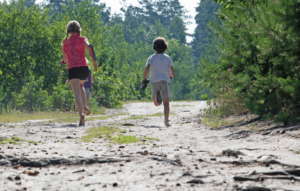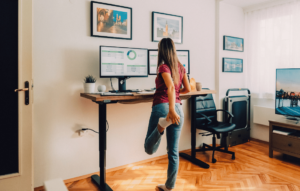Today sitting is everywhere; most people sit most of the day. Our environments – built for convenience and comfort – encourage it at nearly every turn. Whether it’s at a desk, on a couch, or in a car, hours slip away while we remain seated. What many don’t realize, is this sedentary lifestyle we’ve created our reality around, is quietly hurting our health to a pretty shocking degree. Modern experts are now often comparing sitting’s health risks to smoking, and it’s not an exaggeration: we’re living in an era where our environments push us toward a lifestyle that our bodies aren’t meant for.
Unlike our ancestors, who moved constantly as they adapted to ever-changing natural landscapes, we’ve become incredibly used to prolonged stillness. This shift – away from the dynamic, active way humans evolved to engage with the world – has consequences that range from physical issues to even cognitive decline.\

Here’s why our sedentary environments are seriously problematic and what steps we can take to reconnect with a healthier, more natural way of life.
How Modern Environments Harm Us
Human bodies were designed for movement. For millennia, we walked, ran, jumped, climbed, and adapted to our surroundings. Our muscles, cardiovascular system, and mental well-being were built on regular, dynamic activity. However, modern environments – particularly in urban and workplace settings, AKA hunting and gathering – have confined us to chairs and screens, fostering a sedentary lifestyle with serious health implications.
climbed, and adapted to our surroundings. Our muscles, cardiovascular system, and mental well-being were built on regular, dynamic activity. However, modern environments – particularly in urban and workplace settings, AKA hunting and gathering – have confined us to chairs and screens, fostering a sedentary lifestyle with serious health implications.
Heart Health and Cardiovascular Risks
One of the most significant risks of prolonged sitting is its impact on heart health. Sitting for over eight hours a day can increase the risk of cardiovascular disease by up to 34%. When we sit, blood flow slows, fat metabolism decreases, and the body’s ability to process blood sugar is compromised. The result? Higher blood pressure, increased cholesterol, and a greater likelihood of developing heart disease.
Metabolic Health – Weight Gain, and Diabetes
Movement helps regulate metabolism, but when we sit, our metabolic rate drops, burning fewer calories. This inactivity can lead to weight gain, particularly around the midsection – an area prone to fat storage and associated with higher health risks. Weight gain from sedentary behavior can contribute to insulin resistance, paving the way for type 2 diabetes. The issue is particularly severe in urbanized areas, where convenience and efficiency have replaced active lifestyles with a cycle of sitting, commuting, and screen time.
Posture, Spine Health, and Musculoskeletal Issues
Sitting alters posture and compresses the spine, leading to chronic back pain, neck strain, and musculoskeletal imbalances. Poor ergonomic setups at work or home only add to this, creating postural issues that stem from hours of slouching or improper support. Unlike our ancestors, who engaged their core, legs, and back in every movement, modern life often limits us to rigid, unvaried postures that affect our mobility, core strength, and alignment.
Mental Health
Physical inactivity affects not only our bodies but also our minds. In a natural environment, movement stimulates endorphins – the chemicals that boost mood and energy, and reduce stress. By contrast, prolonged sitting can dull these chemicals, contributing to anxiety, depression, and cognitive decline. Urban settings, where we’re surrounded by walls and screens rather than trees and open skies, compound the issue. Studies show that just 10 minutes of movement can increase blood flow to the brain, enhancing alertness and focus, yet our environments rarely encourage these small, health-promoting breaks.
Productivity, Focus, and Energy
Just as the rhythms of the natural world can recharge us, prolonged sitting and stagnation depletes our focus and energy levels. Blood flow to the brain slows during prolonged sitting, which can lead to brain fog, reduced productivity, and a feeling of lethargy. In contrast, an active environment – where we stand, walk, or engage in movement – stimulates mental sharpness, creativity, and motivation. This difference can be especially profound in work environments, where periods of concentration are critical, yet the typical setup often promotes more sitting than movement.

Steps to Reclaim Natural Movement in a Sedentary World
While our environments obviously encourage sitting, there are simple ways to bring more movement into our lives. By intentionally designing daily routines that include varied movement, we can reduce the health risks of prolonged sitting and restore a more natural, health-aligned lifestyle.
Move Every 30 Minutes
One of the most effective ways to break the cycle of prolonged sitting is to incorporate regular movement into your day. Set a timer to remind you to stand up, stretch, or walk around every 30 minutes. Even a brief break can improve circulation, reduce stiffness, and engage the muscles that become inactive while seated. If your workspace permits, consider using a standing desk to alternate between sitting and standing, or take short walking breaks to reset your posture and refresh your mind.
Strengthen and Balance Muscles Affected by Sitting
Sitting weakens muscles like the core, glutes, and back, leading to imbalances that affect posture, strength, and mobility. Combat this by integrating exercises like squats, lunges, planks, and back extensions into your weekly routine. These movements target the muscles that sitting weakens and can help protect you from injuries or chronic pain that stem from sedentary habits. For those with more time, activities like yoga or pilates offer stretching and strengthening benefits that counteract the effects of sitting.
Optimize Your Workspace for Health
Ergonomics can help reduce the strain of sitting. Your chair should provide proper lumbar support, and your feet should rest flat on the floor with your knees at a 90-degree angle. Keep your screen at eye level to avoid neck strain, and, if you use a laptop, consider investing in a separate keyboard and mouse for a more ergonomic setup. Small adjustments like these will encourage better posture and help alleviate the physical toll of sitting.
Infuse Movement into Daily Routines
Look for small ways to add movement throughout your day. Take phone calls while standing or walking, use stairs instead of elevators, and, when you can, walk to a coworker’s desk instead of emailing them. If you work from home, make use of household tasks – fold laundry, take out the trash, or load the dishwasher between tasks – to break up sedentary stretches. These seemingly minor actions compound over the day, adding up to some surprising health benefits.

Integrate Natural Spaces into Your Life
Spending time outdoors and engaging with natural environments can help reset both body and mind. Nature trails, parks, or even short walks outside bring diversity to movement, help counter stress, and improve mental clarity. As we reconnect with natural spaces, we are inevitably reminded of the dynamic, active ways humans are meant to move. Nature is inherently restorative, and time spent outside can provide a refreshing counterbalance to the limitations of our built environments.
Use Technology Mindfully to Promote Activity
Wearable fitness trackers and apps can help remind you to move, offering subtle cues that support a more active lifestyle. These tools track steps, remind you to stand, and monitor your activity levels, keeping you engaged in your health goals. While screens are often part of the sedentary problem, these apps and devices can be used to turn technology into a tool for more mindful and dynamic living.
Conclusion
Our modern environment undeniably promotes a sedentary lifestyle, but by being intentional, we can reclaim the active, dynamic way of living that supports our health. Prolonged sitting impacts nearly every system in the body, from heart health and metabolism to cognitive function, yet simple steps can help offset these risks.
Incorporate regular movement, strengthen key muscles, and re-engage with natural spaces whenever possible. Reclaiming our natural movement patterns isn’t just about preventing physical harm – it’s about reconnecting with the world in a way that aligns with how we evolved to live and thrive. By making movement a priority in a largely sedentary world, we’re not only protecting our health but also strengthening our bond with nature and the rhythms that keep us alive and well.









